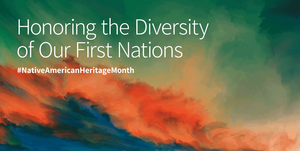Announcements

Updated on 03/23/2025
November is designated as National Native American Heritage Month. This observance commemorates the history, heritage, and culture of Native Americans and Alaskan Natives. It is during this month we acknowledge the vast achievements of America’s original indigenous people.
What started at the turn of the century as an effort to gain a day of recognition for the contributions of the many intertribal cultures, as well as to educate everyone about the rich history, heritage, art, and traditions of the original American peoples made to the establishment and growth of the United States, has resulted in a whole month being designated for that purpose.
In 1914, Red Fox James, a Blackfoot Indian, rode horseback from state to state seeking approval for a day to honor Indians; he was also known as Red Fox Skiuhushu. In December of the following year, he presented the endorsements of 24 state governments at the White House, however, there is no record of such a national day being proclaimed during that time in our history.
Held on the second Saturday of May 1916, the governor of New York declared the first “American Indian Day” on record. Several states followed with celebrations held the fourth Friday in September of the same year. Several states designated Columbus Day as “Native American Day,” but it continued to be a day observed without any recognition as a national legal holiday.
In 1986, the U.S. Congress passed a proclamation authorizing “American Indian Week,” and in 1990, President George H. W. Bush approved a joint resolution designating November 1990 "National American Indian Heritage Month." From 1990 onward, presidential proclamations have been issued annually to celebrate the heritage and culture of Native Americans.
Today, 28 states and many cities, rivers and lakes have names derived from Native American heritage. Native Americans and Alaska Natives are people having origins in any of the original peoples of North, South and Central America, and who maintain tribal affiliation or community attachment. According to the U.S. Census, there were 5.2 million American Indians and Alaskan Natives living in the U. S. in 2010; 7.1 million American Indians and Alaskan Natives living in the U. S. in 2020; and there are projected to be 10.1 million American Indians and Alaskan Natives living in the U. S. by July 2060.
Additionally, Native Americans and Alaskan Natives have a unique relationship with the federal government due to historic conflict and subsequent treaties. To date, there are 574 federally recognized tribes and 324 Native American reservations, recognized tribes across the U.S.
National Native American Heritage Month is celebrated with community gatherings and festivals and government and educational activities. We encourage you to learn more about the traditions and contributions of Native Americans and Alaskan Natives in education, art, literature, government, sports, science and technology past and present.
